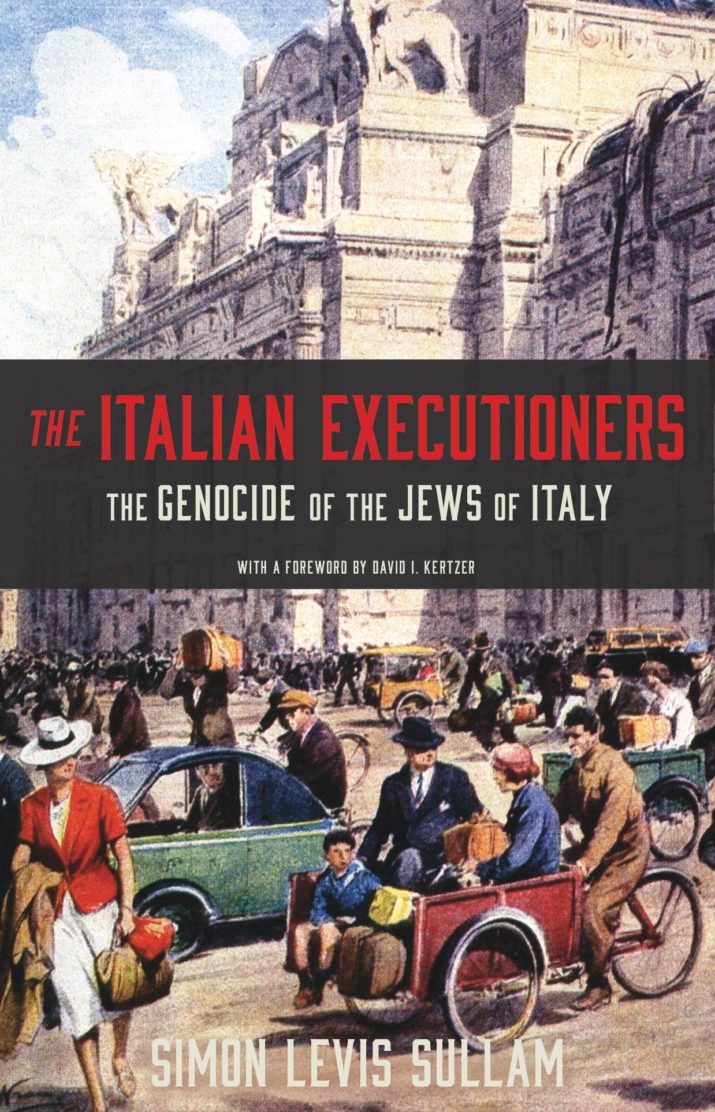
 On the evening of December 5, 1943, while the pianist Arturo Benedetti Michelangeli was giving a concert at the Teatro La Fenice, in Venice, Italian police officers and volunteers of the reconstituted fascist party were preparing one of the largest raids of Jews in the peninsula. It would lead to the arrest of over 160 men, women, and children, the confiscation of all their properties, and their consequent deportation to the Auschwitz extermination camp. While Venetian Jews were arrested and brought to their death, ordinary life in the city went on as if nothing had happened. A few months later, on March 15, 1944, in Rome, following a tip by an Italian informer, the local commissioner of Public Security arrested Enrica Calò, her four adolescent children, her nephew, and her elderly parents for the mere fact of being Jewish. While Enrica and her children would be deported and killed in German extermination camps, after the war the commissioner of Public Security would be acquitted of all charges, thanks to the activities he claimed to have carried out on behalf of the anti-fascist Resistance.
On the evening of December 5, 1943, while the pianist Arturo Benedetti Michelangeli was giving a concert at the Teatro La Fenice, in Venice, Italian police officers and volunteers of the reconstituted fascist party were preparing one of the largest raids of Jews in the peninsula. It would lead to the arrest of over 160 men, women, and children, the confiscation of all their properties, and their consequent deportation to the Auschwitz extermination camp. While Venetian Jews were arrested and brought to their death, ordinary life in the city went on as if nothing had happened. A few months later, on March 15, 1944, in Rome, following a tip by an Italian informer, the local commissioner of Public Security arrested Enrica Calò, her four adolescent children, her nephew, and her elderly parents for the mere fact of being Jewish. While Enrica and her children would be deported and killed in German extermination camps, after the war the commissioner of Public Security would be acquitted of all charges, thanks to the activities he claimed to have carried out on behalf of the anti-fascist Resistance.
These are just two of the many episodes told by Simon Levis Sullam in The Italian Executioners—a detailed, harrowing account of the active participation of ordinary Italians in the deportation of Italian Jews between 1943 and 1945, as well as of the subsequent erasure of their responsibilities and absolution of all guilt during the postwar years. While for decades Italian historians have described Italy during the 1930s and 40s as a benevolent and protective country towards its Jewish citizens, and mostly ignored Italy’s anti-Semitic campaign that prepared the terrain that made the Shoah possible, Levis Sullam’s book tells a very different story. Similar to what Daniel Goldhagen argues for Nazi Germany in his 1996 Hitler’s Willing Executioners: Ordinary Germans and the Holocaust, which is significantly echoed in the title of Levis Sullam’s book, The Italian Executioners argues for fascist Italy, meaning, that many ordinary Italians were willing to become executioners in the extermination of their fellow Jewish citizens, and that this question lies at the heart of Italian national identity.
First published in Italian as I carnefici italiani (Milan: Feltrinelli, 2015), and now published by Princeton University Press in English translation by Oona Smyth and Claudia Patane, The Italian Executioners is a book with many merits. First, it is a direct challenge to the so-called myth of the “good Italian”: a diehard national narrative according to which, during the Second World War, Italians displayed unmistakable signs of their good national character, opposed to the bad character of the Germans, proof that they were fundamentally free from anti-Semitism and racism. As Levis Sullam shows, far from being forced to persecute Jews by the occupying German forces, many Italians actively participated in the discrimination and deportation of Italian Jews. As a matter of fact, historical records show that at least half of the arrests of Italian Jews were conducted by fellow Italians, without orders or direct participation of the Germans.
As David Kertzer mentions in his enlightening preface to the book, the myth of the good Italian was constructed at a very early stage, already during the last years of the Second World War, when Italians, after September 8, 1943, when the nation switched alliance and sided with the war’s victors, had to remake their political identity, and began to present themselves as protective of their Jewish fellow citizens. In the postwar years, the myth was nourished and kept alive by the new anti-fascist ruling class. It is significant, as mentioned by Levis Sullam, that one of the first to use the expression “good Italians” was the Communist leader and Minister of Justice Palmiro Togliatti who, in a 1946 amnesty decree introducing measures that pardoned Italians who committed Fascist crimes, emphasized “the need for reconciliation and pacifications of all good Italians.” With the publication of the 1998 Vatican document We Remember: A Reflection on the Shoah, the Roman Catholic Church too gave its contribution to the strengthening of the myth in as much as the document tried to make a distinction between the religious anti-Semitism that the Church had nurtured for centuries and the racial anti-Semitism that led to the Shoah – a distinction that exempted Italian Catholics from taking responsibilities, either of an individual or a collective nature, in the genocide of the Jews of Italy. Finally, the myth was also kept alive by the works of most Italian historians whose research and publications often ignored the impact of the brutal anti-Semitic campaign, which began in 1938 with the promulgation of the fascist regime’s racist laws. Similarly, those same historians described Italian fascism, anti-Semitism, and racism as phenomena fundamentally extraneous to Italian national history, as well as to the Italian national character. From Benedetto Croce’s well-known definition of fascism as a virus infecting temporarily an otherwise healthy body, almost the product of a contamination coming from abroad, or a parenthesis in a national history of progress, to Renzo De Felice’s argument that Italians as a whole rejected anti-Semitism, Italian historians have struggled to recognize and acknowledge that fascism is also an Italian historical phenomenon; or, to quote Gobetti’s famous definition, that fascism is “the autobiography of the nation;” and, in particular, that the discrimination, deportation and genocide of Italian Jews is not only the work of the German occupiers but also of many Italians who did not hesitate to become willing executioners of their Jewish fellow countrymen.
Second, The Italian Executioners is a clear and effective synthesis of the interpretations proposed in the most important Italian Holocaust studies, which tangentially dealt with the specific topic of the book; and it becomes particularly effective when it establishes a dialogue between traditional and rigorous historical interpretations, such as, to name just a few, Liliana Picciotto Fargion’s Il libro della memoria, Claudio Pavone’s A Civil War: A History of the Italian Resistance, and Giuseppe Maida’s Storia della deportazione dall’Italia, and more theoretical interventions on the subject of genocide and collaboration — from Hannah Arendt’s well-known concept of the banality of evil to Primo Levi’s fundamental notion of the gray zone.
Moreover, by using a wide range of sources, from post-war court records, to police reports, to letters, and personal journals, The Italian Executioners makes use of a very rich and effective methodology, which combines a comparative approach to Holocaust and genocide studies with micro history, as is reflected in the very structure of the book — the first half of which is dedicated to the ideological context and the dynamics that led to the formation of Italian anti-Semitism and prepared the terrain for the discrimination, deportation, and extermination of Italian Jews. The second half of the book, instead, focuses on the dynamics of genocide in various Italian Jewish communities: Venice, Florence, Brescia, and other places in Northern Italy. The ninth chapter of the book is dedicated to a specific and fundamental subject for the understanding of the ideology and dynamics of genocide, i.e., the role played by informers – a grey zone inhabited by people who ranged from police officers, to soldiers, to petty informers, to fascist intellectuals, and whose motives ranged from anti-Semitism, to ideology, to greed, to envy, etc.
Finally, as Kertzer notes in his preface, The Italian Executioners subtly and effectively hints at the larger, fundamental question of the relationship between the erasure of historical memories and the construction of national identity, as well as at the great danger that would be unleashed if the full account of painful historical memories would be entirely replaced, both in memory and in historiography, by an opposite account of national virtues. As Levis Sullam remarks in the conclusions to his books, during the past twenty years, Italian national discourse has been dominated by the tendency to place an ever growing focus on the collective memory of the saviors of Italian Jews – whose number has quadrupled during the past twenty years – at the expense of the executioners. It is as if Italy went from the era of the witness to the era of the savior, skipping the era of the executioner, which would have required an examination of the misdeeds of the past, and which have now, instead, faded into “guilty oblivion.” Significantly, these are the last two words of the book: almost an oxymoron that describes the powerful, dangerous emotion of feeling guilt for something that one cannot remember, or doesn’t want to remember. It is a feeling that separates Italy from those European countries which, in recent years, have undertaken a thorough historical reflection on their responsibilities in the Shoah; and that, unlike Italy, can now look to their future without being paralyzed by feelings of an opposite nature: an unfounded fear and a late nostalgia towards their totalitarian past.
Reviewed by Sergio Parussa, Wellesley College.
The Italian Executioners: The Genocide of the Jews of Italy
By Simon Levis Sullam (Translated by Oona Smyth with Claudia Patane)
Published by Princeton University Press
Hardcover / 2018 pages / 2018
ISBN 9780691179056
To read more book reviews click here
Published on February 5, 2019.




